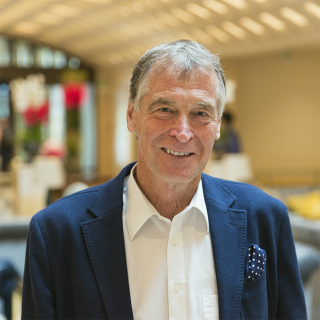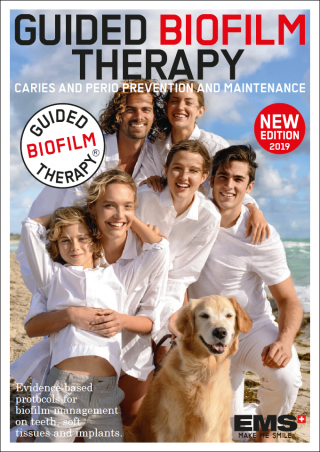A shift in biofilm management
BY DR KLAUS-DIETER BASTENDORF, SCIENTIFIC ADVISOR, SWISS DENTAL ACADEMY
Centuries ago, dentistry identified mineral deposits, such as tartar or calculus, as the main cause of dental disease. Further research then recognised bacterial infections in the roots and the periodontium as the cause of periodontitis. So, what was the logical conclusion? Calculus (tartar) was removed completely.
Today, we know that calculus has a porous surface that provides a niche environment for bacteria and endotoxins. Endotoxins are not absorbed into the calculus, so it can be easily removed. However, extensive removal of calculus is contraindicated and counterproductive.
When I started out as a dentist over 40 years ago, prophylaxis was still in its infancy. At my university, there was minimal literature on everyday oral hygiene. An eye-opening moment for me was during a visit to see Prof. Jan Lindhe in Gothenburg. There, we studied cases of periodontitis that caused almost everyone to cry out: full dentures! We then saw images of the same patients ten years later—they still had their natural teeth, solely thanks to prophylaxis. The thing that made me opt for prophylaxis in dentistry was the birth of my first daughter. I would never have been able to forgive myself if she developed a dental disease. This private passion for preventive dentistry and the vision of Prof. Axelsson and Prof. Lindhe have stayed with me to this day. Although my children and grandchildren’s teeth are healthy, I do see a lot of unhealthy teeth in people in my own generation.
40 years ago, there was a limited understanding of biofilm, individual diagnostics and individual prophylaxis. We removed calculus twice a year, but only introduced individual diagnostics and treatment in 1994. Today, we know the value of prophylaxis. One major reason is that we have a greater understanding of the causes of the most prevalent dental illnesses. The trigger for cavities, gingivitis, periodontitis, peri-implant mucositis and peri-implantitis is always biofilm and not calculus. However, the amount of biofilm is not the determining factor, rather, it is the biofilm’s ecological make-up, type and balance.
Biofilm is a microbial, “organised” collection of microorganisms. The microorganisms are embedded in a matrix of extracellular polymer substances that the microorganisms produce themselves. Microorganisms in bifilm show a different phenotype regarding growth rate and gene expression compared to suspended living cells. Dental plaque is a kind of biofilm and since biofilm forms an adhesive layer, special attention is required to destroy and/or remove it.
Classic…
Currently, there are two technologies available for the manual destruction of oral biofilm, everyday manual biofilm management and professional manual biofilm management. In professional manual biofilm management, we have a range of tools available, including manual debridement with handheld instruments and classic surface polishing, as well as debridement with sonic and ultrasound instruments, such as air polishing systems. Most dental practices still clean the surface of the teeth with manual tools. In initial therapy, after the use of Piezon, we sometimes still use manual tools, though never for maintenance therapy. The correct use of these manual tools is technically challenging and requires a good tactile feel and extensive training. The treatment itself is very time-consuming and tiring for the practitioner, but indispensable for deep pockets of periodontitis that are not being treated surgically. The procedure often leads to oversensitive roots and aesthetically displeasing and noticeable recessions. Manual tools are not well received by patients either and often cause dental practitioners’ hand and arm ligaments to tire. These reasons have led to the need for new tools to be used at regular intervals.
...or modern?
Axelsson and Lindhe have begun to use ultrasound tools in their maintenance therapy. This technology broke through in the 1980s as bulky ultrasound tips were replaced with fine tips based on periodontal probes. I can still remember the introduction of gentler piezo-ceramic ultrasound devices—a real scientific and technological innovation. Only this ultrasound technology allowed linear, low-pain movements. A consensus paper on this topic, published during the EuroPerio 2012 Congress in Vienna, can be summarised as follows:
- Piezo-ceramic technologies have proven effective for manually removing build-up.
- They can be used universally (both sub- and supragingival) to remove mineralised build-up and bacterial biofilm.
- They are gentle on soft tissue.
- They allow for shorter treatment times.
- They cause less pain for the patient.
- They can be used after a short training period.
Today, we know even more. Powder jet devices can be used to clean sub- and supragingival biofilm and staining more efficiently and quickly. Low-abrasion powder based on glycine or erythritol and new subgingival nozzles perform exceptionally well. The literature on powder and water jet technology with low-abrasion powders in biofilm management, compared with manual and ultrasound tools, highlights the benefits of this new technology. Furthermore, air polishing with low-abrasion powder removes more bacteria than manual and ultrasound tools. Many studies have shown that air polishing can remove supragingival build-up and stains much more effectively than classic polishing methods. This applies to soft tissue, hard tissue or restorative materials. Therefore, subgingival air polishing with low-abrasion powder is gentle enough and therefore suitable for use on all dental tissue.
A short guide to powder
The most commonly used powders are sodium bicarbonate, glycine and erythritol. Sodium bicarbonate is a white, crystalline powder with a range of applications in food and medicine and it breaks down at temperatures above 56 degrees Celsius. In wet conditions, sodium bicarbonate, a hydrogen carbonate anion, can neutralise acids. This property explains its central role as the most important blood buffer, since it can regulate the acid-alkali balance in the human body.
Glycine is the simplest stable amino acid that can be made by the human body, where it acts as a radical catcher and neurotransmitter. Glycine is found in almost all foods that contain protein as it is a common building block of almost all types of protein. Glycine is also found in collagen, an important component of tendons, bone, skin and teeth. Glycine is an approved dietary supplement with no maximum dose as it supports various bodily functions. In the food industry, it is often used as a flavour enhancer or humectant. Studies from 2008 onwards have shown that air polishing with glycine powder does not irritate the gingivae.
Now, we come to erythritol. Since 2012, we have almost exclusively used this white, crystalline powder with a pleasantly sweet taste. Erythritol is found in small amounts in nature, for example, in honey, wine grapes, melons and mushrooms and it is produced by the fermentation of natural sugar. Due to its sweet taste, erythritol is used as a sweetener to replace sugar. It has almost no calories when absorbed by the human body and is suitable for diabetics. Oral bacteria are also not able to metabolise erythritol, so it is tooth-friendly and not cariogenic. Various studies have shown that only glycine and erythritol powders do not change the surface structure of composite fillings, while erythritol powder showed no changes on glass ionomer surfaces.
GBT Brochure 2019
Guided Biofilm Therapy (GBT) is a new individual clinical treatment protocol. Decades of experience and research are reflected in a clear eight-step solution: Assessment, disclosing, motivation, AIRFLOW®, PERIOFLOW®, PIEZON®, check and recall. Only GBT gives the practice team the skills, motivation, training and products for the most professional dental cleaning of patients.
GBT perfectly combines air polishing devices and low-abrasion powders. Developed in collaboration with universities and dental practices, GBT is a concept designed for contemporary prophylaxis. Based on decades of scientific knowledge and evidence, GBT is the next step in prophylaxis. The eight steps that comprise GBT can be adapted to suit the treatment and patient, including patients in initial therapy to patients in maintenance therapy, healthy patients, patients with dental caries (especially in the initial stadium), patients with gingivitis, patients with periodontitis, patients with perimucositis and patients with peri-implantitis.
The GBT concept ensures a systematic, quality-orientated approach, from greeting the patient to collecting diagnostic data, everyday oral hygiene advice, professional teeth cleaning, the dentist’s final diagnosis and check-ups and chemically-supported plaque removal, as well as recalls. Alongside the dyeing of the supragingival biofilm, the process of professional teeth cleaning has changed considerably. The modern approach begins with sub- and supragingival biofilm removal using air-polishing technology with Air-Flow Plus Powder®. This erythritol-based powder guarantees a targeted, gentle, risk-orientated removal of the biofilm to support the initial diagnosis. This is followed by the targeted and minimally invasive removal of mineralised build-up with Piezon No Pain®. This approach has many additional benefits, including short treatment times and maximum comfort for both the technician and the patient.
Finally, we can carry out professional biofilm management effectively, gently, safely, quickly and without pain.
Going forward, it is especially important to use the correct devices and tools, such as GBT. Currently, there are a few new products on the powder market. However, in addition to the powders’ properties and scientific evidence that these powders are biocompatible and do not cause damage, it has become more and more important for powders to be compatible with dental devices. This is a strength exhibited by Switzerland-based EMS, who have not only significantly contributed to the development of GBT, but have also provided suitable devices and tools (AIRFLOW® PROPYHXLAXIS MASTER, AIR-FLOW® POWDER PLUS, AIR-FLOW® handpiece, PERIO-FLOW® handpiece, PERIO-FLOW® nozzle, Piezon No Pain®).
The scientific knowledge and technological progress for a paradigm change in professional prophylaxis has now been established. Now comes the time to integrate these developments into our everyday practice for the wellbeing of our patients and ourselves.


